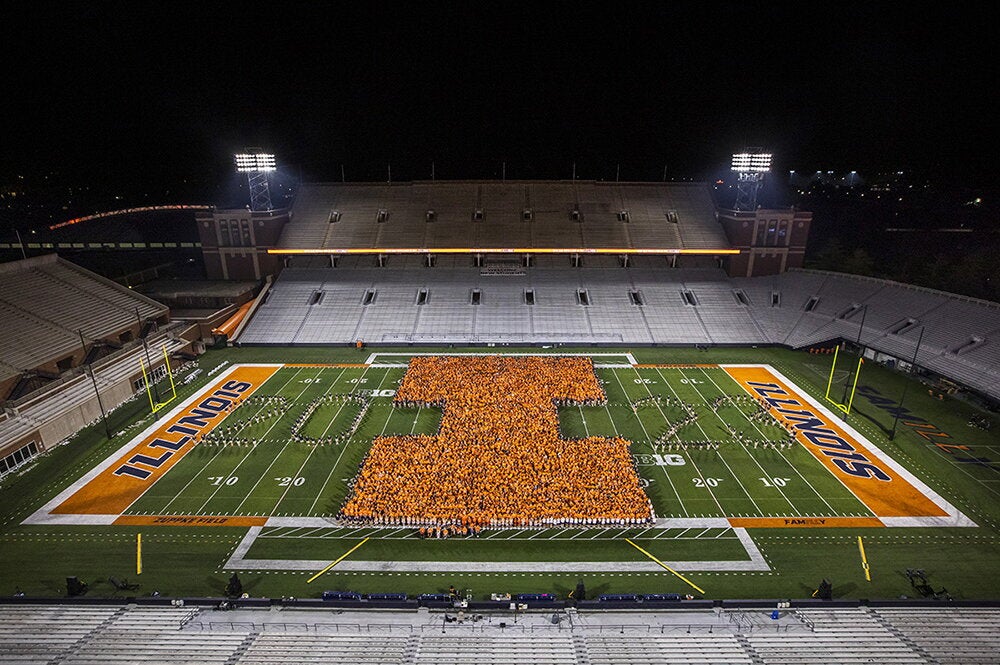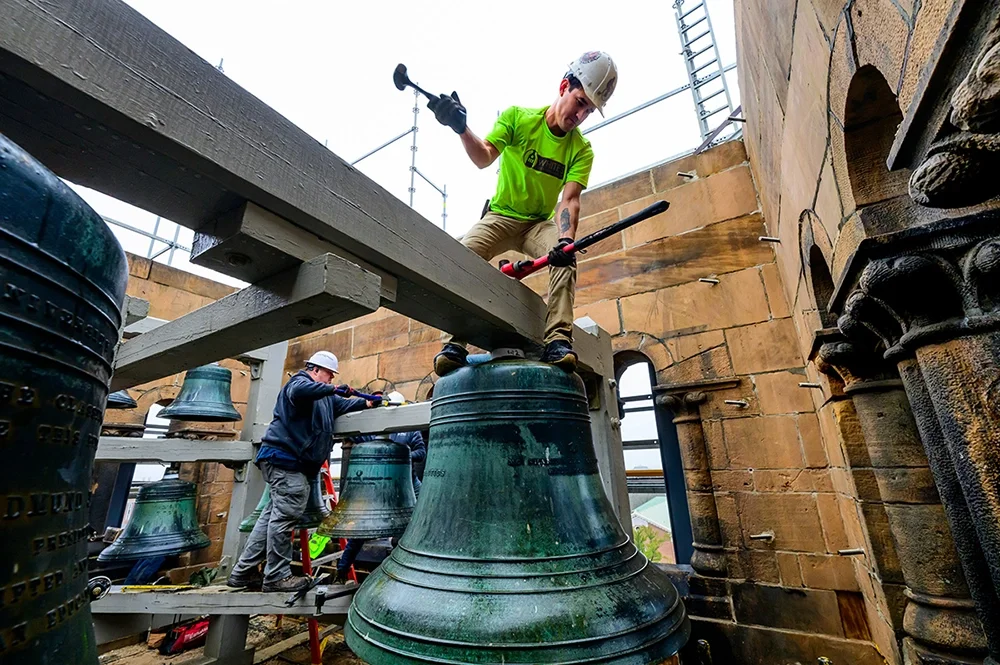
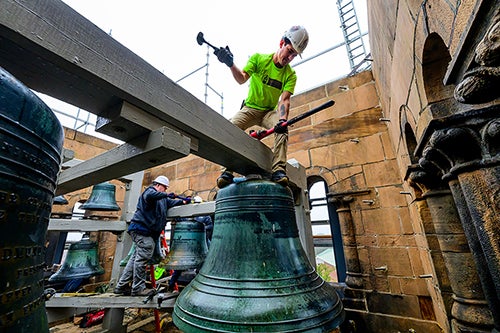
(Photo by Fred Zwicky.)
A large crane is parked on the north side of Altgeld Hall on this sunny and mild mid-December morning. As I watch from near the Alma Mater statue, the arm of the crane that extends far above the scaffolding surrounding Altgeld’s bell tower lowers a cable into the top of the tower, which has had its roof removed.
Minutes later, the crane lifts one of the iconic bells out of the top of the tower. The bell is lowered to a flatbed trailer below, and two workers guide it onto the trailer and remove the strap and chains securing it to the cable.
For more than 100 years, the tower’s 15 bells have provided a soundtrack for the University of Illinois Urbana-Champaign campus. This is the first time since they were installed in 1920 that they have been removed.
The removal of the bells is part of a massive renovation project of Altgeld Hall that began in the spring of 2023. The current phase of the project includes structural improvements to the bell tower. In preparation for that work, a specialty contractor for installation, repair and maintenance of bell systems — White’s Clock and Carillon Northeast, Inc. of Pulaski, New York — is overseeing the bells' removal.
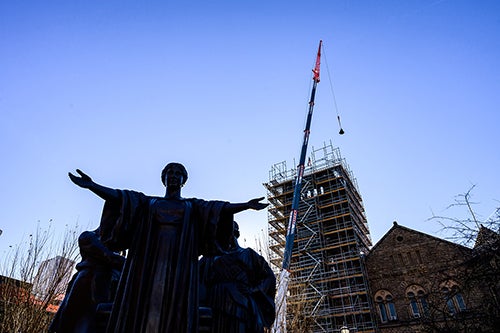
The bells have a combined weight of seven-and-a-half tons, with the largest weighing 3,000 pounds and measuring 5 feet in diameter and the smallest weighing 300 pounds.
The bells had been bolted to a wooden frame in the tower. Yesterday, workers put metal collars around the top of the bells to hold the bolts in place after the bells are detached from the frame. The bells’ clappers were taken out and stored separately.
“Getting them off the frame is the time-consuming part,” says contractor James White, who is directing this work.
It’s a tight fit to remove the bells from the top of the tower. The space is compact, and the bells must be maneuvered around the frame and the other bells. It turns out that the smallest bell is the hardest to get out of the tower, White says.
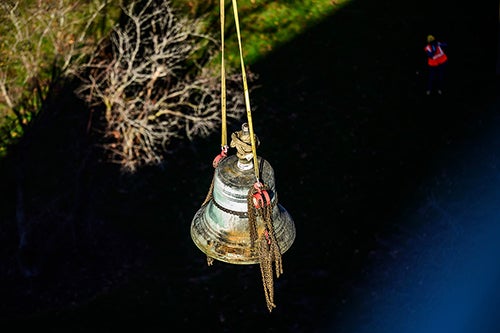
Once they are out of the tower and sitting on the trailer, the bells’ greenish-gray patina is easier to see. It’s part of the natural aging of the bells and not a detriment to their function, so no restoration work is planned for the bells, White says.
“We don’t really want them to look brand new again. We want a seasoned bell. They’re in good shape,” he tells me.
White's company will replace the cables that attach to the bells and are used to play them.
The bells will be kept in a U of I storage facility for a few months until the work on the tower is finished. Returning the bells to the tower will be more time-consuming and meticulous to ensure they are in the correct position, White says. The wooden structure that holds the bells also is being removed, and it will be repaired if needed before it is returned to the tower, he says.
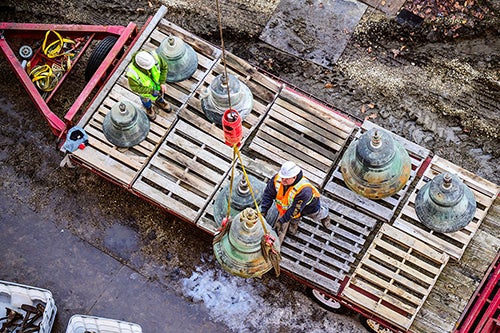
In the weeks before the bells are removed from Altgeld, temporary steel beams were added to brace the tower and keep all the stone in place as the roof was lifted off, says Nick Roussey of Grunloh Construction. Roussey, the site supervisor, is coordinating and overseeing the multiphase project. Horizontal beams were bolted around the turrets on each corner, with columns the height of the tower connecting them. The roof offered the tower additional bracing, Roussey tells me. Without the roof in place, there is a chance the stone walls might start to bow out.
With the new supports in place, workers attached two steel cables to the roof and cut the bolts that attached it to the building. A huge crane lifted off the roof and placed it on the ground outside Altgeld. A new roof will be installed, and the top of the tower will get a new floor where the bells’ wooden frame sits, Roussey says.
The construction crew added new grout to the stone inside the tower, and with the bells out of the tower, they’ll start installing a new steel structure to reinforce its walls. From a vantage point on the scaffolding at the top of the tower, I can see bolts that have been drilled into the stone jutting out diagonally in the tower’s corners. Steel plates will attach to the bolts and vertical steel columns will connect the plates.

Before the bells were removed and work in the tower begins, workers made structural reinforcements to the walls below. The roof of each turret on the tower was removed, and workers drilled 104 feet down to the building’s foundation and inserted rebar and grout. Watch a video of that process.
The north and east walls of the original part of the 128-year-old building were reinforced with 1-foot-thick concrete sheer walls. A brick wall with crumbling mortar stood inside the sandstone exterior. More than a foot of brick was removed to make room for the concrete wall. The remaining brick was regrouted and rebar drilled into it horizontally every foot. Then workers poured the concrete walls from Altgeld’s first floor to the third-floor chimes cabin for structural support.
Roussey says the most challenging part of the project has been scheduling all the different trades needed for the various kinds of work required. He particularly likes projects that preserve old buildings, and he says he’s proud of the work that’s been done to renovate Altgeld Hall.
“We did it the right way,” Roussey says. “This bell tower will just need a little tender loving care for the next 200 years.”
Editor’s notes: More information about the Altgeld Hall renovation project is available online. For project inquiries, contact Steve Breitwieser.
